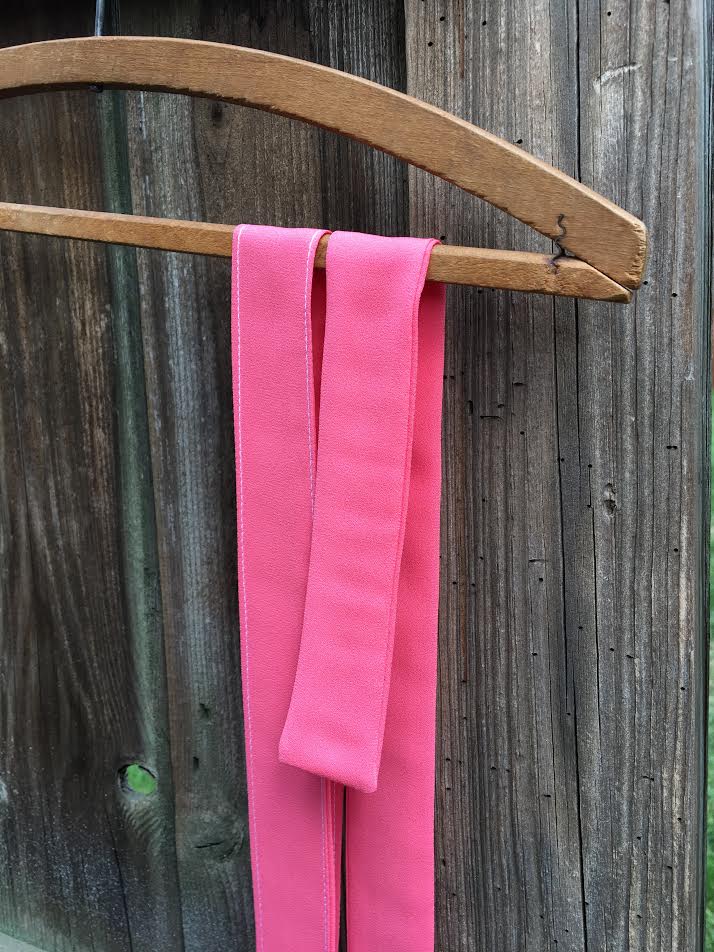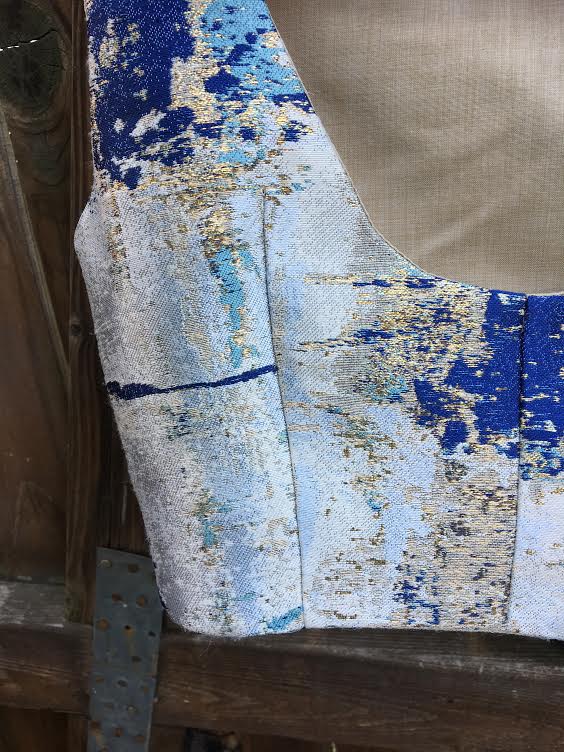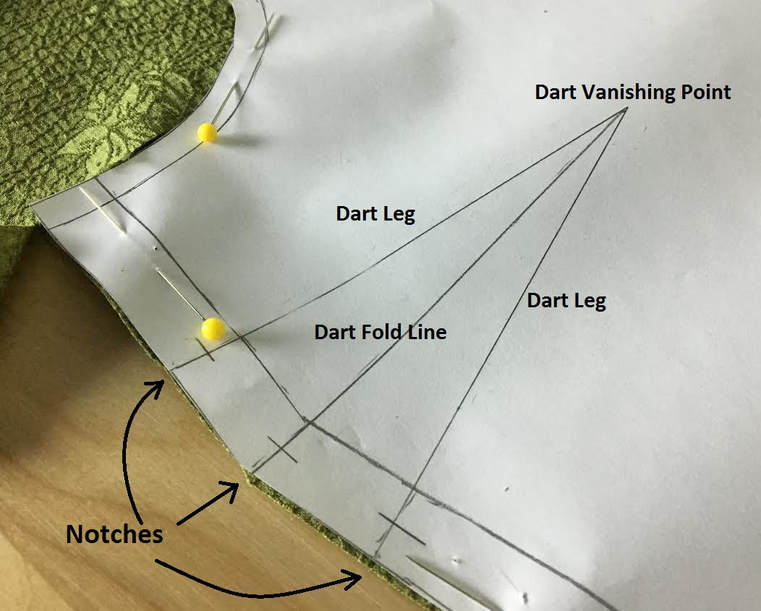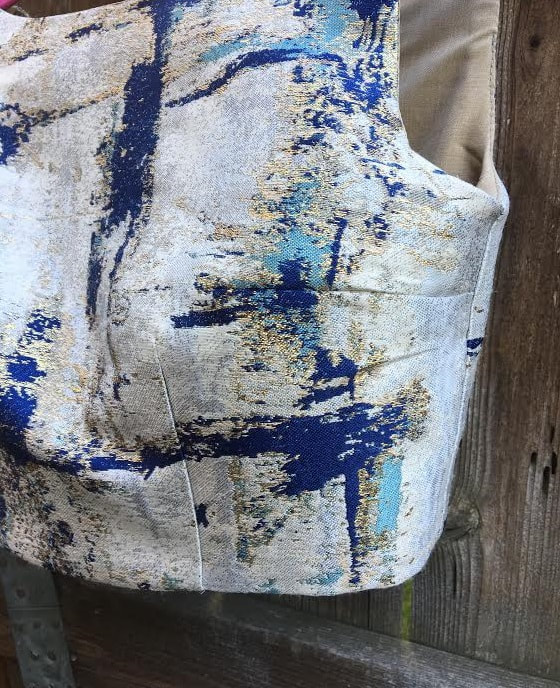|
This week's tutorial will be a very simple one. It has been inspired by a cute little sash I recently made for a cute little flower girl. To make the sash match the fabric of the bridesmaid dresses, I treated the construction of the sash as I would with any conventional waist tie. So this brought me to another thought: considering its sewing simplicity, wouldn't a waist tie make a really pretty addition to any old dress or tunic top that needs to be replenished a bit? In the steps below, I'll show you two techniques for sewing a professional waist tie: The self-finished folded method and the lined method. A waist tie can take on many styling challenges and serve a number of different functions. Yes, it's a great little bow builder for a flower girl, but it can also make a perfect stylistic element for any dress that needs an update. A tie waist look is classic, accentuates the waistline, and can hide a majority of size and design issues. If this sewing tutorial has already peaked your interest, here are some tips on how and where to start if you want to vamp up a dress in your closet with a waist tie sewn by you! Consider these three elements: Fabric, color and drape. FabricChoose a fabric that either matches the weight, thickness and texture of the dress or vise versa, an opposite that compliments the dress' design and fabric. You could of course sew the waist tie out of any scrap fabrics you already have, but I suggest that you pay close attention to what also works with the dress both visually and functionally. If mismatched however, make sure the combo looks intentional. For example, if you are adding a tie to a very lightweight silk dress, a waist tie made of stiff, textured fabric (like linen or wool) may not feel or look the part. Vise versa, if the dress is more structured, a very thin, flimsy waist tie may be overpowered or simply not withstand the dress both functionally and visually. So that being said, if you're rummaging through scrap fabrics trying to find the perfect tie material, keep these fabric-related elements in mind. ColorOn the topic of color: you can and should use your design eye. I suggest choosing a color that works in combination with the rest of the dress to ensure a cohesive look. Sometimes when it comes to color opposites attract, so you can certainly color block! What you want to avoid however, is making the waist tie look like an add-on that simply doesn't belong. Because it is a removable piece, color blocking doesn't always work as it can make the tie feel as if it is not intentionally part of dress. If you can't find a matching color, I suggest either staying within the same basic color scheme but choosing a darker or lighter shade, or making the separate tie in a neutral like black. DrapeAlthough drape goes hand-in-hand with fabric, I think it's important to consider it separately as it will affect the design and overall look of the garment. Consider how you would ultimately like to knot or style the waist tie. A lightweight fabric with high draping capabilities carries less bulk and for that reason, works well with a longer waist tie.
Vise versa, if the fabric is stiff with no natural drape, you should almost look at it more as a belt. When styling a more structured waist tie, I suggest either making it shorter or wrapping it around the waist a few times so that the hanging ends are nicely contained at the waist. A tie made from drape-less fabric can look bulky and overwhelm a garment if the loose ends are long and left floating at the bottom. Ultimately, it is really up to your taste and design eye to decide what fabric, color and drape is best suited for your waist tie addition (or sash)! But now that I got some of my own suggestions out of the way, let's get started on the sewing portion of this tutorial. As mentioned above, it will be a fairly simple and hopefully a fun one! I'll walk you through two separate techniques both resulting in almost the same edge finished style. Choose your method based on how much fabric you have available and what is most suitable for your sewing experience. Hint: You'll find that the first technique is more simple and has less steps to fiddle with.
1 Comment
Here I am writing another post about darts... My obsession aside, the importance of darts in dressmaking is essential to grasp both as a sewing beginner as well as an advanced dress and pattern maker. While my previous tutorials focused on understanding the structure of darts and how to sew them, today's post will shift its attention to dart logistics. Perhaps, it will answer some questions you've often asked yourself in your own sewing process. I'll walk you through all the concepts below, but if you landed on this page desperately looking for a detailed tutorial on transferring and sewing darts, check out this oldie but goodie: Everything You Need To Know About Darts In Sewing. The video tutorial above should give you a better visual on how to correctly pin and sew single pointed darts which go hand-in-hand with some of the concepts discussed below. The Importance Of Darts In Garment ConstructionTo understand darts at their core, you have to understand why they are so essential in garment construction. A dart works to convert fabric from flat to 3-dimensional. While darts are very simple triangle-like shapes, the architecture relies on the dart vanishing point- the point where both dart legs and the middle fold line meet. Check out the image below for some visual clarity on these three elements. So how does such a simple shape mold to the human form? Dart points radiate to some of the highest points on the body. They take in the excess that extends to these points gradually and smoothly. Darts are conventionally added the curviest areas of the body. Naturally, that is the bust, waist and hip areas. The dart's widest part always corresponds to the slimmest portion on the body, while the vanishing point blends into the wider areas. The best example of this concept of course are bust and front waist darts which regardless of how they are positioned on the bodice, will always have vanishing points radiating to the apex- the highest point on the bust. Keeping this logic in mind, you can shift the dart excess anywhere on the bodice as long as this point of gravity remains the same. Side note: this rule is perhaps the most basic yet widely used in pattern drafting. Following that same logic, back darts, whether single pointed or double pointed (contour darts), gravitate to the highest points on the upper back. Below the waistline, dart vanishing points are aligned with the widest/highest areas of the hip. In the back, dart vanishing points will blend into the highest point on the bottom. Following a very simple concept, darts are able to adapt to the organic shape of the human form, adjusting to any body type and size in a very simple fashion. In the design and pattern drafting process, darts are also important landmarks for moving excess around. For example, a basic blouse pattern with darts can be easily converted to princess style by re-directing the dart’s excess to the seams. If darts aren’t present, you wouldn’t know exactly how much excess needs to be taken out at each princess seam. That being said, they are an essential part of basic blocks which are simple sewing patterns used for generating new patterns in a variety of styles and sizes. |
The Blog:A journey into our design process, sewing tutorials, fashion tips, and all the inspiring people and things we love. Doina AlexeiDesigner by trade and dressmaker at heart. I spend most of my days obsessing over new fabrics and daydreaming new ideas. Sadie
Executive Assistant & Client Relations Manager Archives
November 2019
Categories
All
|
-
Sewing Tutorials
-
Basics
>
- Aligning Pattern Grainlines To Fabric
- Preparing Fabrics For Sewing
- Pinning Sewing Patterns To Fabric
- Placing Sewing Patterns On Fabric For Cutting
- Rotary Cutters or Fabric Scissors?
- Cutting The Sewing Patterns
- What Are Notches And How To Use Them In The Sewing Process
- Transferring Notches From Pattern To Fabric
- Transferring Seamlines to Fabric
- Staystitching
- Backstitching: A Complete Guide
- Hand Basting: A Complete Guide
- Sewing Continuous Bias Binding
- Darts >
-
Sewing Seams
>
- The Basics Of Seams And Seam Allowance
- How To Sew A Straight Seam
- Sewing Curved Seams
- Sewing Corner Seams
- Trimming And Grading Seam Excess
- Notching/Clipping Seam Allowance for Tension Release
- Sewing Topstitched Seams
- Sewing Corded Seams
- Sewing A Slot Seam
- Sewing A Gathered Seam
- Sewing Bias Seams
- Sewing Seams With Ease
- Sewing Seams With Crossing Seamlines
- Sewing Unlike Fabric Seams
- How To Iron Seams: Ironing Tools And Conventions
- Sewing With Knit Fabrics
- Understanding Stitch Length And Tension
- Sewing Unique Fabric Seams
-
Seam Finishes
>
- Seam Finishing Techniques - Overview
- Applying A Pinked Seam Finish
- Applying A Bias Bound Seam Finish
- Serging And Zigzag Seam Finishes
- Sewing A Self-Bound Seam Finish
- Sewing A French Seam Finish
- Sewing A Hong Kong Seam Finish
- Sewing A Mock French Seam Finish
- Sewing A Turned-and-Stitched Seam Finish
- Sewing Overcast Hand-Applied Seam Finishes
- Sewing A Flat Felled Seam
- Sewing A Hairline Seam Finish
-
Hem Finishes
>
- Garment Hem Finishes: Overview
- Sewing A Double Fold Hem Finish
- Sewing A Single Fold Hem Finish
- Sewing Bound Hem Finishes
- Sewing An Exposed Double Layer Bound Hem
- Sewing A Folded-Up Bound Hem with Pre-folded Binding
- Sewing A Hong Kong Hem Finish
- Sewing A Band Hem Finish
- Sewing A Bias Faced Hem Finish
- Sewing A Twill Tape Hem Finish
- Sewing A Rolled Hem Finish
- Sewing A Shaped Hem Facing
- Using Fusible Hem Tape And Webbing
- Finishing A Lace Fabric Hem
- Finishing A Leather Hem
- Sewing Faced Hem Corners
- How To Finish Lining At The Hem
- Finishing Fabric Corners by Mitering >
- Interfacing A Hemline: Lined And Unlined Examples
-
Sewing Pockets
>
- Curved Patch Pocket With Flap
- Unlined Square Patch Pockets
- Lined Patch Pockets: Two Ways
- Extension On-Seam Pockets
- Separate On-Seam Pocket
- Front Hip Pockets
- Bound Double Welt Pocket
- Double Welt Pocket With Flap
- Self-Welt Pocket (Using Single Fabric Layer)
- Slanted Welt Pocket (Hand-Stitched)
- Faced Slash Pockets: Overview >
-
Sewing Zippers
>
- Sewing Zippers: General Information
- Sewing A Centered Zipper
- Sewing A Lapped Zipper
- Sewing An Invisible Zipper
- Sewing A Fly Front Zipper
- Sewing A Closed-End Exposed Zipper (No Seam)
- Sewing An Exposed Separating Zipper
- Sewing Hand Stitched Zipper Applications
- Sewing A Zipper Underlay
- Sewing A Placket-Enclosed Separating Zipper
- Sleeveless Finishes >
-
Neckline Finishes
>
- Sewing A Neck Shaped Facing
- Sewing An All-In-One Neck Facing
- Neck And Garment Opening Combination Facings >
- Sewing A Bias Faced Neckline Finish
- Sewing A Band Neckline Finish
- Bound Neckline Finishes: Overview >
- Sewing A Semi-Stretch Strip Band Neckline
- Ribbed Neck Band And Classic Turtleneck
- Decorative Neckline Finishes >
- Finishing Facing Edges >
-
Extras
>
- A Complete Guide on Interfacing
- Sewing Bound Spaghetti Straps
- Sewing Spaghetti Straps To A Faced Neckline
- Sewing Ruffles: Overview
- Patterning And Sewing A Circle Ruffle
- Sewing A Gathered Heading Ruffle
- Sewing Double Layer Gathered Ruffles
- Sewing A Gathered Ruffle Into A Seam
- Sewing A Gathered Ruffle To A Fabric Edge
- Sewing A Fabric Surface Slit
- Sewing A Slit Seam
- Hand-Applied Straight Stitches
- Hand-Applied Blind Stitches
- Hand-Applied Overedge Stitches
- Hand-Applied Tack Stitches
- Hand-Applied Decorative Stitches
-
Basics
>
- Custom Bridal
- Custom Apparel
- About
- Blog
Services |
Company |
|







 RSS Feed
RSS Feed

